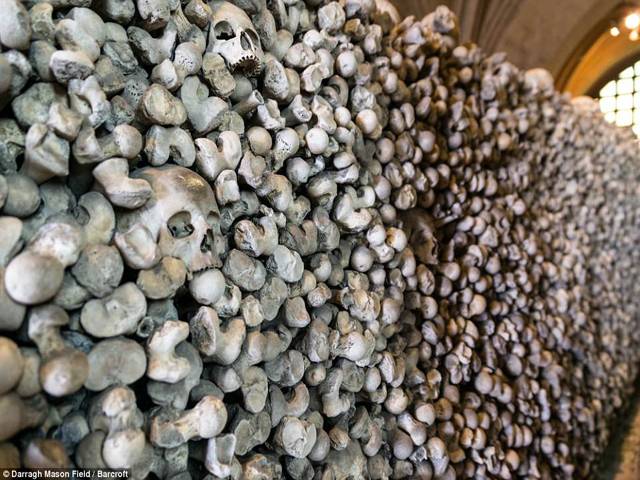LONODN-It may look like a scene from Indiana Jones, but this huge collection of human skulls and bones is far from fictional.
A small church in Kent is home to one of the largest and best-preserved collections of ancient human bones and skulls in Britain. The collection includes over 1,000 skulls on the shelves in four arched bays, and one single stack of bones is over 1.8m in height.
The morbid crypt is housed at St Leonard’s Church, Hythe, Kent.
Photographer Darragh Field visited the collection in June last year and has taken stunning photographs.
He said: ‘It’s the best collection of ancient bones and skulls in the country and one of only two ossuaries in the UK, so I had to go and see for myself.
‘The bones were thought to be remnants of those who fell in the battle of Hastings, but it turns out they were local residents from the 13th to 15th century. ‘The remains are mostly female with only a few skulls showing signs of trauma from blows.’
Although it is impossible to estimate the number of bones in the collection, recent work has guessed that the total of individuals represented in the stack is approximately 2,000.
A number of the skulls indicate breakages and injury, whilst others have evidence of disease from deficiencies and infection.
Despite the macabre setting, the photographer found the atmosphere calming.
He said: ‘It felt serene and peaceful, it’s very atmospheric and very well kept, a real hidden gem.
‘There is no doubt looking at a wall of human skulls is not your everyday experience but this didn’t feel sad or oppressive as these people mostly died from natural causes.’
In an ironic twist, one of the skulls had signs of life after death.
Mr Field said: ‘The best surprise I got from the crypt was seeing a birds nest in one of the skulls!’
The collection is similar to the Fontanelle cemetery in Naples, which was used as a mass grave for victims of the plague of 1656.
Visitors bring gifts for the bones - which some believe create a link between the living and the dead - and ask for favours in return.
But the largest collection of human remains in the UK is at London’s Natural History Museum, comprising around 25,000 individuals and representing a worldwide distribution of the human population.
Friday, April 19, 2024
Chapel in Kent decorated with remains of 2,000 locals who died 800 years ago

dm
3:56 PM | March 28, 2024
4:14 PM | March 23, 2024
Formula 1 returns to China for Round 5
9:05 PM | April 19, 2024
Germany head coach Julian Nagelsmann extends contract till 2026 World Cup
9:00 PM | April 19, 2024
IMF urges Italy, France to spend less, Germany to loosen purse strings
8:57 PM | April 19, 2024
PM calls UAE president, admires Emirati leadership's response to recent Dubai rains
8:55 PM | April 19, 2024
Church leader calls for including Christians in Gandhara Corridor
8:50 PM | April 19, 2024
A Tense Neighbourhood
April 19, 2024
Dubai Underwater
April 19, 2024
X Debate Continues
April 19, 2024
Hepatitis Challenge
April 18, 2024
IMF Predictions
April 18, 2024
Kite tragedy
April 19, 2024
Discipline dilemma
April 19, 2024
Urgent plea
April 19, 2024
Justice denied
April 18, 2024
AI dilemmas unveiled
April 18, 2024
ePaper - Nawaiwaqt
Advertisement
Nawaiwaqt Group | Copyright © 2024





